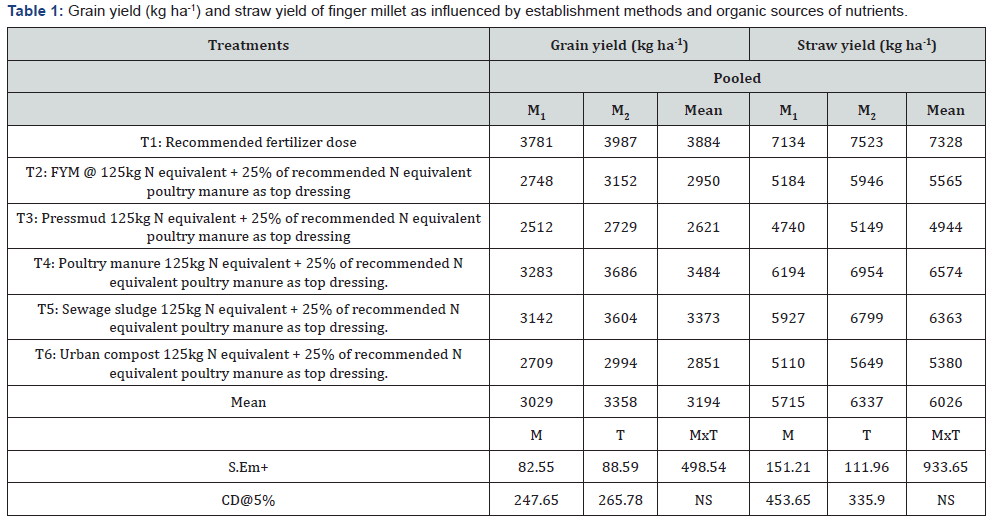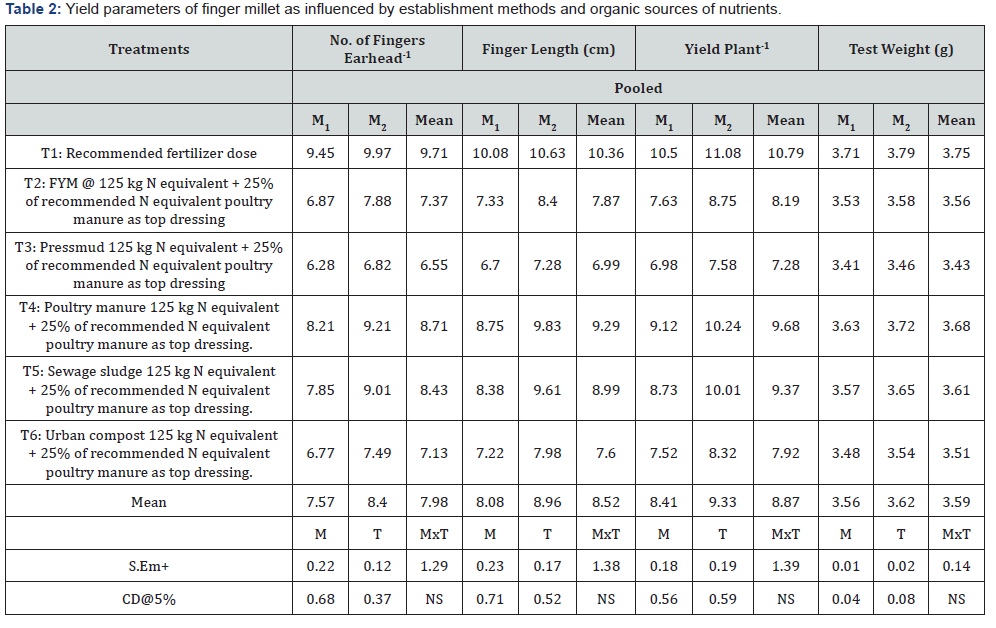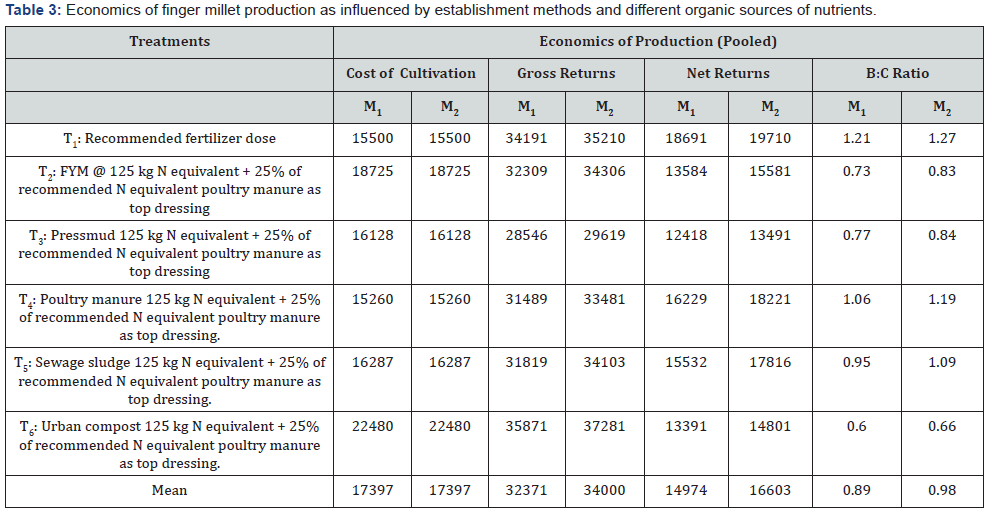Effect of Different Establishment Methods and Organic Nutrient Sources on Yield, Yield Attributes and Economics of Finger Millet (Eleusine coracana (L) Gaertn)
Prakash P1, Sharanappa2 and Nagaraju3
1 Department of Agronomy, Organic research station, India
2Department of Agronomy, India
3Department of Agronomy, India
Submission: June 02, 2018; Published: June 15, 2018
*Corresponding author: Prakash P, Department of Agronomy, Bengaluru, Senior Farm Superintendent, Organic research station, Naganahalli, India, Email: milletprakash@gmail.com
How to cite this article: Prakash P, Sharanappa, Nagaraju. Effect of Different Establishment Methods and Organic Nutrient Sources on Yield, Yield Attributes and Economics of Finger Millet (Eleusine coracana (L) Gaertn). Int J Environ Sci Nat Res. 2018; 12(3): 555836. DOI: 10.19080/IJESNR.2018.12.555836.
Abstract
Field experiment was conducted during kharif 2006 and 2007 at Zonal Agricultural Research Station, Mandya to study the effect of different establishment methods and organic nutrient sources on productivity of finger millet. Soil of the experimental site was red sandy loam in texture, low in organic carbon (0.43%) and available nitrogen (270.60kg ha-1), medium in available P2O5 (32.25kg ha-1) and K2O (149.80kg ha-1). Treatment consisted of 12 treatment combinations two main plot treatments of methods of cultivations (puddled and aerobic soil condition), six nutrient sources in sub plot (T1: Recommended fertilizer dose (FYM 10t+100:50:50 N:P2O5:K2Okg ha-1), T2: FYM@125kg N equivalent+25% of recommended N equivalent poultry manure as top dressing, T3: Pressmud 125kg N equivalent+25% of recommended N equivalent poultry manure as top dressing, T4: Poultry manure 125kg N equivalent + 25% of recommended N equivalent poultry manure as top dressing, T5: Sewage sludge 125kg N equivalent+25% of recommended N equivalent poultry manure as top dressing, T6: Urban compost 125 kg N equivalent+25% of recommended N equivalent poultry manure as top dressing) were laid out in split plot design with three replications. The results indicated that aerobic method of cultivation recorded significantly higher grain yield (3358 kg ha-1 kg ha-1), straw yield (6337kgha-1 kg ha-1), yield parameters, net returns (Rs. 16603ha-1) and B: C ratio (0.98) compared to puddled condition. Among the different organic nutrient sources application of poultry manure 125kg N equivalent+25% of recommended N equivalent poultry manure a top dressing recorded significantly higher grain yield (3484kg ha-1 kg ha-1), straw yield (6574kg ha-1 kg ha-1), yield parameters, net returns (Rs.16229 and Rs.1822 1akh ha-1) and B: C ratio (1.06 and 1.19) in both puddled and aerobic condition and which was on par with application of sewage sludge 125kg N equivalent+25% of recommended N equivalent poultry manure at top dressing.
Keywords: FYM; Finger Millet; Poultry Manure; N Equivalent; Grain; Straw
Theoretical Basis and Methodology
Finger millet, Eleusine coracana (L) Gaertn is one of the important millet crops grown in southern dry zone of Karnataka. In India Karnataka stands first in area (7.1 lakh ha) and production (13.0 lakh tonnes). The crop is mainly being cultivated in rainfed areas in resource-poor soils with less management. Being millet it is highly suitable for less input agriculture like organic agriculture. Hence an attempt was made to develop the organic nutrient management practices for finger millet under different establishment methods. Modern management practices rely on chemical fertilizers and pesticides that have led to decline in soil organic matter, increased soil erosion and pollution of surface and ground water [1,2]. The low productivity and risk are the other problem in the arable cropping system. High production cost and reliance on loans to purchase inputs are the major risks especially in rain fed areas where yields are uncertain [3]. Organic method is self-sufficient and self-dependent as compared to modern chemical farming with principle of nutrients capturing and relying more on organic inputs that is need of the hour. Organic farming minimizes the use of external inputs and aims at optimization of crop productivity rather than its maximization through renewal and strengthening of ecological processes and functions of farm ecosystem [4]. Therefore the use of locally available agro-inputs in agriculture by avoiding or minimizing the use of synthetic agrochemicals appears to be one of the probable options to sustain the agricultural productivity. Various organic nutrient sources are available which contain good amount of major plant nutrients to produce comparable yields [5]. Therefore, an investigation was under taken to study the effect of organic nutrient sources on yield and economics of finger millet under different establishment methods.
Material and Method
Field experiment was conducted during kharif 2006 and 2007 at Zonal Agricultural Research Station, Mandya, University of Agricultural Sciences, Bengaluru to “Study the effect of different establishment methods and organic nutrient sources on productivity of finger millet”. Soil of the experimental site was red sandy loam in texture, low in organic carbon (0.43%) and available nitrogen (270.60kg ha-1), medium in available P2O5 (32.25kg ha-1) and K2O (149.80kg ha-1). Treatments consisted of 12 combinations of two main plot treatments (methods of cultivation) and six nutrient sources in sub plot (T1: Recommended fertilizer dose (FYM 10t+100:50:50 N:P2O5:K2Okg ha-1), T2: FYM@125kg N equivalent+25% of recommended N equivalent poultry manure as top dressing, T3: Pressmud 125kg N equivalent+25% of recommended N equivalent poultry manure as top dressing, T4: Poultry manure 125kg N equivalent + 25% of recommended N equivalent poultry manure as top dressing, T5: Sewage sludge 125kg N equivalent+25% of recommended N equivalent poultry manure as top dressing, T6: Urban compost 125 kg N equivalent+25% of recommended N equivalent poultry manure as top dressing) were laid out in split plot design with three replications. The variety used was Indaf 9 it was developed at Zonal Agricultural Research Station, Visweshwaraiah Canal Farm, Mandya, University of Agricultural Sciences, Bengaluru. This is a short duration variety and comes to harvest in 105 days. The variety is suitable for both irrigated and rainfed condition (Tables 1-3).

M1: Puddled soil condition
M2: Aerobic soil condition
RDF: Recommended Dose of Fertilizer (100:50:50 kg N:P2O5:K2O ha-1)
NS: Statistically not-significant

M1: Puddled soil condition
M2: Aerobic soil condition
RDF: Recommended Dose of Fertilizer (100:50:50 kg N:P2O5:K2O ha-1)
NS: Statistically not-significant

M1: Puddled soil condition
M2: Aerobic soil condition
RDF: Recommended Dose of Fertilizer (100:50:50 kg N:P2O5:K2O ha-1)
The relevant yield and yield parameters were recorded at harvest and subjected to statistical analysis. The economics of the finger millet was worked out considering the prevailing cost of inputs and price of output. All the results were then analyzed statistically for drawing conclusion using analysis of variance (ANOVA) procedure [6]. The price of inputs that were prevailing at the time of their use was considered for working out the cost of cultivation. Gross returns = Total value of the produce (grain and straw). Cost of cultivation = Cost of inputs, labour, power etc. Net returns = Gross returns - Cost of cultivation. The benefit cost ratio was worked out by using the following formula.
Benefit Cost ratio=Net returns (Rs ha-1)/Cost of cultivation (Rs ha-1)
Materials and Methods
Significantly, higher grain yield (3358kg ha-1) and straw yield (6337kg ha-1) of finger millet was registered in aerobic method of establishment as compared to puddle method of establishment (3029 and 5715kg ha-1, respectively). The higher seed yield in aerobic method of establishment was a result of better yield attributing parameters viz., number of fingers per ear head (8.40), finger length (8.96cm), grain yield plant-1 (9.33g) and test weight (3.62g). This might be due to continuous supply of oxygen to root zone resulted in higher uptake of nutrients which resulted in higher dry matter and better translocation of source to sink relation leads to higher yield and yield attributing parameter. The results are in the line.
Application of recommended dose of fertilizer recorded significantly higher grain yield of finger millet (3884kg ha-1) as compared to organic source of nutrients. Among different organic source of nutrients application of poultry manure 125 kg N equivalent+25% of recommended N equivalent poultry manure as top dressing recorded significantly higher grain yield (3484kg ha-1) and straw yield (6574kg ha-1) and which was on par with application of sewage sludge 125kg N equivalent+25% of recommended N equivalent poultry manure as top dressing (3373 and 6363kg ha-1, respectively) as compared to all other source of nutrients. The higher grain yield with application of poultry manure 125kg N equivalent+25% of recommended N equivalent poultry manure as top dressing was a result of better yield attributing parameters viz., number of fingers per ear head (8.71), finger length (9.29 cm), grain yield plant-1 (9.68 g) and test weight (3.68g) and which is on par with application of sewage sludge 125kg N equivalent+25% of recommended N equivalent poultry manure as top dressing. The increase in grain yield and its components is a result of better growth and growth components. Application of poultry manure could have released the nutrients slowly into the soil solution to match the required absorption pattern of finger millet. Probably, the adequate supply of nutrients could have resulted in higher uptake of nutrients like nitrogen, phosphorous and potassium and resulted in higher grain yield of finger millet [7,8].
Economics
Mainly crop production is dependent on market price of inputs and quantity of output produced and its price in the market. Higher cost of cultivation (Rs.17397 ha-1), gross returns (Rs.34000 ha-1), net returns (Rs.16603 ha-1) and B: C ratio (0.98) was found significantly higher in finger millet grown under aerobic condition as compared to puddled situation (Rs.17397 ha-1, Rs.32371 ha-1, Rs.14974 ha-1 and 0.89, respectively). Among different nutrient sources, application of poultry manure 125 kg N equivalent + 25% of recommended N equivalent poultry manure as top dressing recorded significantly lower cost of cultivation (Rs. 16287 ha-1), gross returns (Rs.31489 and Rs. 33481 ha-1), net returns (Rs.16229 and Rs. 18221 ha-1) and B: C ratio (1.06 and 1.19) in both puddled and aerobic condition.
Conclusion
Among different organic nutrient management practices application of poultry manure 125kg N equivalent + 25% of recommended N equivalent poultry manure as top dressing has been found superior with respect to yield and economics of finger millet.
References
- Relyea RA (2005) The impact of insecticides and herbicides on the biodiversity and productivity of aquatic communities. Ecological Applications 15: 618-627.
- Singh RB (2000) Environmental consequences of agricultural development: case study from the green revolution state of Haryana. Indian Agric Ecosystem and Environ 82: 97-103.
- Eyhorn F, Ramakrishnan M, Mader P (2007) The variability of cotton based organic farming systems in India. Int J Agric Sustainability 5: 25- 38.
- Shukla A, Patel BR, Patel AN, Patel AR (2011) Organic farming for sustainable agriculture. Kisan World 38(3): 39-42.
- Ghosh A (2005) Organic rice farming technology development and its feasibility. Indian Farming 55(9): 4-7.
- Gomez KA, Gomez AA (1984) Statistical procedures for agricultural research (2nd edn.); John Wiley and Sons, New York, UK.
- Maskey SL, Bhattarai S, Karki KB (2004) Long term effect of different sources of organic manures on wheat soybean rotation. SAARC J Agric 2: 243-256.
- Adikant P, Rajput AS, Katlam BP (2009) Organic kodomillet (Paspalum scrobiculatum L) production through organic waste of forest produces. Mysore J Agric Sci 43(3): 574-576.






























